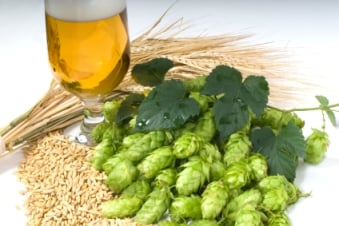
This week we take a close look at hop utilization in the whirlpool. With the wild popularity of IPA beer styles, whirlpool hops have become an important part of modern brewing.
Whirlpool Hopping and Aroma Oils
Whirlpool or “steeped” hopping is a technique where you add your hops after flame-out and let them steep at hot temperature for a period of time before chilling the wort. In a professional setting, a pump creates a “whirlpool” in the boiler which helps to settle the trub out before chilling and transferring to a fermenter.
The main purpose of whirlpool hopping is not to add bitterness, but instead to capture volatile hop aroma oils in the beer. Most of the aroma oils in hops have a boiling point lower than that of water. As a result the aroma oils will quickly boil off if you add the hops in the boil. So we add hops either in the whirlpool or as dry hops to preserve these oils.
Whirlpool Hop Utilization
While whirlpool hops are primarily used for capturing aroma oils, the hops are added at a temperature where “isomerization” still occurs. Isomerization of the alpha hops creates “isomerized alpha acids” which are the main bittering compound in beer. So adding whirlpool hops will still add some bitterness to the beer.
A secondary, and often ignored factor is the effect of boil hops that carry into the whirlpool. For example, imagine adding hops 10 minutes before the end of the boil. That hops will generate some bitterness in the boil, but it will still have quite a bit of alpha acid left as we switch into the whirlpool. So it will continue to generate some bitterness in the whirlpool.
For simplicity, lets first consider the utilization of hops added in the whirlpool, then we’ll look at the more complex boil carryover case.
Calculating hop bitterness in the whirlpool is similar to calculating it in the boil. Hop bitterness is a function of boil (or steep) time, amount of hops used, boil volume, boil gravity, and the alpha acid percentage of the hops. The same basic relationships apply to the whirlpool.
The only major difference is that in the whirlpool, the hops are at a lower temperature, so the isomerization process takes place at a much slower pace. In fact, below boiling it drops off very rapidly. As a result the temperature and time of your whirlpool additions are very important.
If we calculate the hop utilization for an equivalent boil hop using the time, volume and gravity of the wort for the addition, we can then apply the “whirlpool utilization” to this number to estimate the overall hop utilization. Here’s a look at the whirlpool utilization with temperature assuming 100% would be an equivalent boil hop:
- Formula: Utilization = 2.39 * 10^11 * e^(-9773/T) where T is in Kelvin
- Boiling: 100 C (212 F) – Utilization is 100%
- At 90 C (194 F) – Utilization is 49%
- At 80 C (176 F) – Utilization is 23%
- At 70 C (158 F) – Utilization is 10%
- At 60 C (140 F) – Utilization is 4.3%
- At 50 C (122 F) – Utilization is 1.75%
So we can see that the utilization drops very rapidly with temperature. Even at the quite hot 90C (194 F) case we are getting half of the isomerization of an equivalent length boil.
Keep in mind, however, that isomerization is a byproduct of whirlpooling. The main goal of whirlpool hop additions is to preserve volatile hop oils that don’t really want to go into solution and boil off quickly. So often a slightly lower whirlpool temperature can work to your advantage.
The main reason we calculate whirlpool hop utilization is so we don’t accidentally upset the IBU balance of our beer when using a large amount of whirlpool hops.
For hops carried forward from the boil, the utilization calculation is more complex. You first have to have some idea of what percentage of the hop alpha acids were isomerized in the boil, and the amount left that could be isomerized in the whirlpool. From that basis you can then apply the utilization formulas and factors in the whirlpool over the entire whirlpool period.
To do this accurately you need to estimate it for each hop addition individually and then add the result together. I won’t try to cover the detailed calculation here but the above outline along with the standard hop formulas can get you there.
Whirlpool Hops in BeerSmith 3
BeerSmith 3 has a variety of features to capture the effects of whirlpool hops including hop utilization in the whirlpool as well as hops carried forward from the boil.
For whirlpool hops, you can set both the time and temperature of each whirlpool hop addition and BeerSmith will estimate the IBU contributions of each addition.
For hops carried forward from the boil there is a new setting in the equipment profile where you can specify the total whirlpool hop time as well as a check box for “Estimate Boil Hop Util in the Whirlpool” which will carry forward the boil hops to the whirlpool based on the whirlpool time and estimate bitterness for those as well.
If you want to learn more about the new settings in BeerSmith 3 you can watch this short video.
Hopefully this helped to clear up your understanding of hop utilization in the whirlpool. Thanks for joining me on the BeerSmith Home Brewing Blog. Be sure to sign up for my newsletter or my podcast (also on itunes…and youtube) for more great tips on homebrewing.